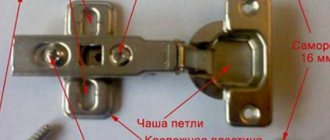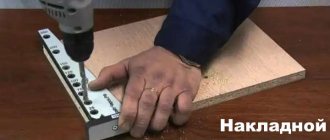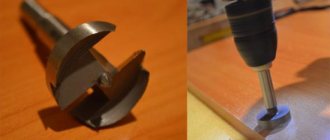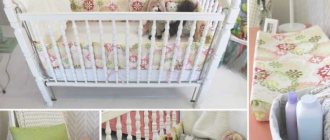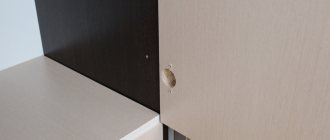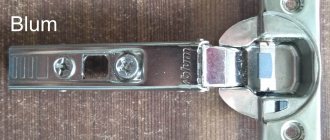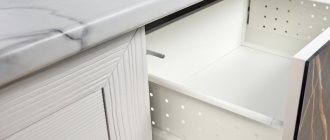136485
Today, due to the dynamic development of new technologies, the requirements for the design and manufacture of products intended for furnishing premises have increased. Modern and functional steel and furniture hinges come in a wide variety of varieties, on which the durability of household items depends when used. Correctly chosen fittings give the furniture strength and take it to a higher design level.
Types of loops by design
They are hinge units that connect the doors to the cabinet body. Various design solutions make it possible to leave the door leaf open at a certain angle. Based on the method of fastening facades, you can choose the following models:
- Four-jointed.
- Mezzanine.
- Pianos.
- For glass doors.
Quadruple joint
The most common and popular are 4-hinge furniture hinges. They are distinguished by their versatility and high reliability. There are three types of four-hinged hinges, which differ from each other in the method of fastening the shoulder cup to the striker:
Slide-on. The protruding part of the strike plate fits into the shoulder. Fastening is carried out with a fixing screw. The connection has notches on both sides. The length of the arm can be lengthened or shortened by securing the connection with notches.
Clip-on. This system allows you to do without a screw. The parts of the loop are connected by a latch. Such canopies are called quick installation models. The cabinet door can be removed and replaced without tools.
Key-hole. The cup arm is placed with a hole on the counter plate screw. The edges of the opening are inserted under the screw. The mounting hole resembles a keyhole.
Their varieties are used depending on the position of the closed door relative to the wall of the cabinet body. There are the following four-hinged types:
- invoice;
- semi-invoice;
- loose-leaf;
- corner;
- inverse;
- adit.
Ferrari hinge series
| Series | Cup diameter | Milling depth for cup | Series features |
| Slide on 95 | 35 mm | 11 mm | Loops in this series are the most common. To install on the pad, the hinge is “slided” onto the pad so that the mounting pad screw fits into the groove on the back of the hinge arm (see section “Installing Hinges”). In the MDM assortment, this series is represented as widely as possible - various types of hinges are available (inset, overhead, middle), as well as various installation and opening angles. |
| Slide on 96 | 35 mm | 11 mm | Externally they look like the hinges of the Slide on 95 series, differing from them in the type of spring - these hinges work to open the door throughout the opening cycle (unlike standard four-hinge hinges, which work in two directions - at the beginning of the opening cycle the spring tends to close the door, then , approximately from the middle of the opening cycle, the spring tends to open the door). Hinges of this series are used with the MAGIC system and are used in high-tech furniture (without handles on the doors). |
| Anyway Clip 90 | 35 mm | 11 mm | Hinges of this series are designed for quick installation, as well as for doors with 3 or more hinges. Their peculiarity is that there is no need to “push” the loop at a certain angle onto the platform; it snaps onto it from any position without the use of tools. Removing the hinge is also extremely simple - just pull the latch at the end of the hinge arm. Installation and dismantling of furniture can be done by one person. Large doors with three or more hinges cannot be installed alone. In the MDM assortment there is only one hinge of this series (straight invoice 90/110). |
| Mini 12 | 26 mm | 11.5 mm | Designed for lightweight doors. The hinges of this series differ from the Slide-on and Anyway Clip series by having a smaller cup diameter and, therefore, a lower maximum load. In the arm of the hinge there is a hole in the shape of a key hole, with which it is installed on the platform. These hinges are available for both chipboard doors and glass doors. |
| MiniMAX | 26 mm | 10 mm | Hinges in this series are also designed for small doors. They differ from the Mini 12 series in their smaller milling depth, and, accordingly, the ability to use chipboards with a thickness of 12 mm or more. The Slide-on type fastening allows independent adjustment (for more details, see the MiniMAX section). MiniMAX is designed for a greater number of opening/closing cycles than Mini 12. These hinges are available for both chipboard and glass doors. |
Changing the installation angle
If four-hinged hinges do not allow the doors to open to the desired angle, use additional pads. You can purchase them at a furniture supermarket.
The platforms are made of plastic and metal. Place it under the hinge's mounting bar, and the angle will change in the desired direction. For example, a 10-degree overlay can either increase or decrease the installation angle of the façade.
Along with one-dimensional tabs, there are universal ones with angle adjustment. The installation platforms are equipped with a mechanism that changes the angle of inclination of the strike plate (adjustment is carried out using a screwdriver).
Adjusting the angle using a bolt
Installation
How to install a furniture canopy yourself? To do this, you first need to stock up on everything you need:
| Tool | Purpose |
| Drill | Make holes in the right places |
| Awl | Marking drilling points |
| Pencil | Drawing loop outlines |
| Screwdriver | Tightening screws |
| Self-tapping screws | Fixing the canopy |
The instructions for the work performed look like this:
- We apply markings with our own hands , guided by the following rules:
- the marking line is placed 22 mm from the edge of the facade;
- the outer canopies, if more than two of them are installed, are marked at a distance of 80-110 mm from the ends of the door;
- the averages are distributed evenly.
Tip: be sure to make sure that the hinges do not coincide with the location of the shelves and partitions, as this will lead to unnecessary inconvenience.
- Using an awl, mark the centers of future holes for screws.
Using an awl we put the necessary marks
- We drill holes no more than 13 mm deep . At the same time, make sure that the drill is positioned strictly at a right angle to the surface being treated, otherwise you may damage the facade cladding.
Creating the required grooves for fastenings
- We attach the loop and tighten the screws with a screwdriver . You can also use an electric screwdriver for this purpose.
Fixing the canopy on the facade
- We check the mechanism for functionality and the door for any distortions.
Planting cup
The most common diameter of the loop cup is 35 mm. There are models with 26 mm and 40 mm cups. You can drill out seats in the body of a door made of chipboard or MDF using a milling cutter. Pay attention to the depth of the cutter and the thickness of the facade. The mass reserve under the cup should be at least 3 - 4 mm.
The location of the holes along the height of the door is not limited in any way. Make markings for the hinges on the facade at a distance of ¼ of the length from the top and bottom of the door.
Keep the edge of the recess circle from the end of the facade at a distance of 4 - 5 mm. It's best to use a template.
Tips for choosing
A properly selected furniture hinge will ensure long-term use of the furniture. It is worth paying attention not only to the cost of products, but also to the main characteristics. Recommendations from experts will help you decide:
- The method of opening the door and the dimensions of the hinge are specified. Small facades require small canopies, and vice versa.
- Attention is paid to the manufacturer, the optimal ratio of cost and quality.
- During an external inspection of furniture corner hinges, the presence of dents, cracks and other defects is checked.
- Fittings must be certified in the Russian Federation; reliable sellers always have supporting documents.
- You should trust only specialized stores that sell original products. Qualified consultants will help you make the right choice and provide information on installation and maintenance of products.
Advantages of pine furniture board, scope of its application
All straight and corner furniture hinges, except cupless ones, are produced with or without closers. The action of this device can be compared to a shock absorber, which ensures smooth, silent closing of doors, without hitting the furniture body. Among the undoubted advantages of such an addition are an increase in the service life of structures, resistance to loads, and protection against leakage of oil and working fluid. The models are adjustable and serve for the tightest fit of surfaces.
For thick facades, hinges with a cup diameter of 45 mm are selected. A good option would be spring reverse models.
Specify the method of opening the door and the dimensions of the hinge
Pay attention to the manufacturer, the ratio of cost and quality
Check for dents, cracks and other defects
Selection and installation methods
Before purchasing a specific hinge model, you need to know the angle of the cabinet front to ensure convenient door opening.
To place the hinges correctly, purchase a template. Companies such as Blum offer special marking devices as an accompanying product for their products. Using the template, you can easily make markings for self-tapping screws on the front and side of the cabinet, and also accurately determine the center of the cutout using a crown for the recess for the cup.
If you learn video better than text, watch Evgeniy’s video from the BlackAsb channel, which clearly shows the rules for installing furniture hinges:
What is an overhead and inlay loop?
Structurally, the loops are very similar. They consist of:
- cup located on the mounting plate;
- counter fastening loop;
- hinged device.
An inset furniture hinge is attached to a drilled hole; an overhead hinge does not require a recess. Why is this design difference needed, and what is the difference between inset and overhead furniture hinges:
- The position of the doors relative to the facade changes. If the fastening is overhead, the door overlaps the end of the body strip. When hanging in a mortise, it is visible; the door goes deep into the body.
- The hinges are suitable for furniture structures of various thicknesses. Inserting furniture hinges is impossible without the use of a cutter; an 11 mm recess is made into the cabinet strip for the cup. With the minimum standard thickness of cabinet furniture (16 mm), it is difficult to install. Furniture manufacturers sometimes press the hinge cup into the cabinet panel during the manufacturing process.
- The response plate has a different bend; the inset hinge has less bending; it swings open due to hinges.
Number of hinges for cabinet door
The standard number of hinges on a sash is 2 pieces. However, cabinets can be more than 2 meters high and quite wide. Based on this, you will need to determine exactly how many turning devices you need so that they can withstand the significant load from a massive door. To do this, you need to know the weight of the door leaf and refer to the table:
Types of furniture hinges and their purpose
The main purpose of furniture hinges is clear to everyone - to ensure comfortable opening of the movable door of a cabinet or cabinet when attached to the side of the cabinet. The division into types of furniture hinges according to their purpose is made for the convenience of selecting the optimal option. Which hinge to choose depends on the type of facade and the design of the furniture body itself.
What types of furniture hinges are there?
Currently, four-hinge furniture hinges are mainly used to equip the facades of cabinet furniture. This is the most extensive group of hinges, allowing adjustment of the facade in three planes - this is the most important advantage over other types of canopies.
Also, their distinctive feature can be identified by the installation method - for this, the inner surface of the facade and sidewalls are used, and not the ends of the furniture. Moreover, it is necessary to make a hole in the facade for cutting in the hinge bowl, with a diameter of 35 mm. Rarely - 26 mm, if a so-called mini-hinge is used - a mini-copy of a standard four-hinge hinge identical in design.
Types of four-hinged furniture hinges
Four-hinged furniture hinges, which are common for cabinet furniture, consist of a cup with an elbow and a counter (fastening strip).
These two forming parts can be connected in different ways. According to this method, the four-hinged hinge is divided:
- Slide-on - both parts of the loop slide into each other and are fastened with a screw (due to which the adjustment is made).
- Key-hole - both parts are passed into each other and connected through a loop (keyhole).
- Clip-on - both parts are snapped to each other, that is, they are connected in a screwless way.
Types of furniture hinges by purpose
“Straight” hinges with an opening of 90-110 degrees
This includes standard furniture types, overhead, semi-overlay and internal types.
The invoice is also an external loop. Designed for installation of facades that completely cover the body from the sidewalls (not counting the technological gap of 2-3 mm for each door).
A half-overlay loop is used when the sidewall with fasteners is covered halfway. Typically used in three-door cabinets and double-opening wall cabinets.
Inset - also known as an internal loop. Used to install facades recessed relative to the body. But more often it is used for wall cabinets with a top opening, if the top lid hangs like a “visor”.
Adit, straight - it is also a loop for false panels. To install the facade not on the sidewall, but on a false panel located in the same plane as the facade. Mainly used in corner kitchen modules and on sink tables.
Corner hinges with standard opening 90-110 degrees
They are mainly used for corner facades located at 45 (135) degrees relative to the body, less often - for end modules - with an opening angle of 30, 60 degrees.
But in reality there are many more corner loops. But they are not in particular demand, since the need for them arises very rarely, in specific design projects.
Inverse hinges with increased opening angle up to 180 degrees
They also come in overhead, semi-overlay, inset, adit, and corner, but they provide a much larger opening angle, practically turning the façade 180 degrees. Needed to increase access to the interior of the cabinet when the standard 90-degree opening is not enough. Such loops are also called transformers, due to the complex design of the shoulder.
Carousel loop, aka crocodile
A specific type of hinge used for transformable doors that open like an accordion. Most often it can be found in sink tables, in combination with a direct inverse loop.
Almost all of the considered types of four-hinge furniture hinges are produced both in a standard version and are equipped with a closer - a special soft-closing mechanism. The closer can be built into the hinge arm or snap onto the bowl or arm.
What other types of furniture hinges are there?
The remaining types of furniture canopies are used from time to time, to solve some specific problems. They are fastened with self-tapping screws without much difficulty.
- Piano and card hinges are good for fastening movable sashes where adjustment is not needed. For example, in folding tables, books, folding tables, etc.
- Pin and heel hinges are also attached to the ends of the body and facades, like the previous type. Used to highlight a certain antique look of furniture.
Separately, we can also highlight:
- Overhead cupless hinges.
- Mortise hinges.
- Spring hinges.
As well as specific furniture hinges that are not used for ordinary facades made of chipboard, MDF, solid wood, etc. But they are also divided into the same types as four-joint ones, simply differing in appearance due to their functional purpose:
- Hinges for glass facades with and without drilling.
- Hinges for facades assembled from an aluminum frame.
These are, perhaps, all the main types of hinges that are used in the production of cabinet furniture and can easily be found on sale.
Drilling a hole
Install a 35 mm cutter in the drill and make a hole according to the markings. Keep the drill or screwdriver vertical while working. Otherwise, chips and damage may occur. The cut should be 12-13 mm deep.
- DIY cornice: a detailed description of how to design and decorate a stylish interior element (80 photos)
DIY folding chair: 110 photos, drawings, diagrams and sketches of convenient and easy options for creating portable chairs
- Do-it-yourself pouf: step-by-step instructions on how to build a stylish and original interior element with your own hands (105 photos)
If you drill the hole deeper, cracks will appear on the front of the door. Therefore, at this stage you need to be extremely careful and careful. Drill all the remaining slots in this manner.
Installation video
This video shows the process of installing an internal hinge on a glass door. As you can see, the process is not complicated, but it is still better to seek help from a specialist.
Single-joint
Often, when making various cabinets and pencil cases with their own hands, home craftsmen use single-hinged products. According to the principle of operation, they do not differ from the widely used door hinge, but they are smaller in size, have an improved design and a more aesthetically pleasing decorative finish.
These products include two half-loops and two plastic seals. The disadvantages of this type of mounting elements include:
- low reliability of fastening the glass sheet;
- impossibility of adjustment.
However, many people prefer this type of installation products due to:
- cheapness of the product;
- ease of installation.
In addition, the latest samples of single-hinged devices have a fairly attractive appearance, improved design and various types of modern decorative coating.
Without an element such as a furniture hinge, we will not be able to open or close cabinet doors. This is an important component of furniture. Whether it's a closet, bedside table, sideboard or table, with the help of hinges we can open the doors up, down, to the sides at a certain angle. Nowadays there are many types of this furniture fittings; the choice is simply huge.
Without an element such as a furniture hinge, we will not be able to open or close cabinet doors.
Their installation is quite complicated, it is better if the installation is carried out by a specialist.
What are furniture hinges? This is a mechanism attached to the wall and facade of furniture; with its help, the doors can open at a specific angle. Such hinges differ in structure, fastening system, and they perform different functions.
They are invisible when the doors are closed.
Many manufacturers of furniture hinges produce low-quality fittings because they want to save on production.
Today, four-hinged hinges are common. This design is quite unpretentious and durable, easy to install. This mechanism is so thorough that you can open and close furniture doors endlessly. Its adjustment is allowed in three planes. The four-hinge hinge includes the following elements:
- mounting plate,
- cup,
- shoulder.
Detachable ones are divided into left and right - this is how they differ from universal ones, which are fixed to a facade that opens in any direction.
To purchase a quality product, it is worth looking at the thickness of the metal.
The hinges are mounted to the facade with a cup, and attached to the furniture frame with a mounting strip. The entire mechanism is fixed with self-tapping screws. The shoulder serves as a kind of handle and a connecting link between the mounting plate and the cup. All elements are connected to each other by a four-hinged mechanism. There is an adjusting screw in the bar; it allows you to adjust the façade relative to the base.
Nowadays there are many types of this furniture fittings; the choice is simply huge.
To choose furniture hinges, you need to consider how you will install them.
How to use furniture hinges correctly
To ensure that the doors close and open smoothly, that there are no gaps between the base and the facade, and that the doors are attached fairly evenly, it is necessary to correctly install furniture hinges. As you know, hinges have cups of different diameters - it is this part of the structure that is inserted into a recess drilled in the wood. The most popular ones have a diameter of 35 millimeters.
The hinges are mounted to the facade with a cup, and attached to the furniture frame with a mounting strip.
To install correctly, you will need a tape measure, an awl, a drill, a screwdriver or screwdriver, a Forstner drill, and self-tapping screws. But the first thing you need to do is make markings and determine the center of the future recess. It is necessary that there is 5 mm from the cup to the edge of the door or 23 mm from the edge to the middle of the recess. Now we drill the opening to such a depth that the cup fits completely into it, the main thing is not to drill through the material. We place hinges in the prepared facade and, if necessary, level them with a plank. When everything is aligned, the bar fits like a glove, we attach it to the screws using a screwdriver or screwdriver.
This design is quite unpretentious and durable, easy to install.
As you can see, the types of furniture hinges can be different, and their installation does not present any difficulties; all the work can be done at home. In such cases, when the doors become misaligned and they begin to creak, you can easily replace the old fittings with new ones yourself, and the furniture will last for a long time.
Today, four-hinged hinges are common.
Furniture hinges: types and differences
It would seem that such a small detail as a furniture hinge does not deserve such close attention from the buyer and manufacturer as, for example, the mechanisms of sofas, the quality of wood or upholstery. However, this opinion is erroneous, because the doors of cabinet furniture, as a rule, are opened very often. And, if the hinge turns out to be of poor quality and quickly breaks, the façade of the furniture product, which, as we know, is its “face,” also loses its aesthetic appeal.
The beauty of the product, its functionality, and durability will depend on what type of furniture curtains you choose when ordering furniture. Let's talk about how some types of loops differ from others. First of all, it is necessary to distinguish between different designs of furniture curtains: four-hinged and piano curtains. The first type is more modern; today it is used by almost all manufacturers of cabinet furniture. Grand pianos are a slightly outdated variety, but even today they are used in the furniture industry. They are often used in the production of folding sofas and armchairs.
Overlay loop
This is the most common type of curtain in the modern furniture industry. With the help of such an element, the facade is strengthened at an angle of 90˚, and the hinge gets its name due to the fact that the facade is literally superimposed on the end of the side wall of the furniture and completely covers it.
Semi-overlay loop
With its help, the facade is also attached at a right angle, but in this case relative to the internal partition of the furniture. Another difference from overhead curtains is that the facade covers only half of the end of the side wall. Such furniture hinges are most often used in cabinets with three or four facades, separated by several internal partitions.
Inner loop
It also helps to mount facades at an angle of 90˚, but the doors are installed inside the furniture body. A neat visual frame is formed around the door from the ends of the side walls. Externally, the internal curtain is very similar to the semi-overhead curtain, however, they are distinguished by a significantly larger bend of the internal curtain.
Hinges at other angles
In addition to curtains that secure the door at right angles, there are also other degrees for hinges.
Often in pencil cases and cabinets, 45-degree hinges are used, which are attached to the side wall. When installing facades for various kinds of corner products: cabinets, cabinets, pencil cases (most often we are talking about kitchen furniture, where corner products with opening facades are most appropriate), 175˚ hinges are used.
Less commonly, in the manufacture of cabinet furniture, so-called 135 degree carousel hinges and 165 degree transforming hinges are used.
How to choose the right furniture hinges
Many manufacturers of furniture hinges produce low-quality fittings because they want to save on production. To purchase a quality product, it is worth looking at the thickness of the metal. If it is thin, it is better to refuse the purchase. It is worth paying attention to the price equivalent - it is better not to purchase cheap accessories. The number of items depends on the size of the façade and its weight. The hinges must be durable; this determines how long they can last.
This type of fittings, such as furniture hinges, currently produced and used in furniture assembly.
You can easily replace old fittings with new ones yourself, and the furniture will last for a long time.
To choose furniture hinges, you need to consider how you will install them. Many people pay attention to where they were made. After all, most of the accessories are produced in China, and there, as you know, they are manufactured under various brands, including well-known ones. It is important to pay attention to the product certificate, whether the head office controls production, since most popular companies open branches in the Middle Kingdom.
There are many types of furniture hinges.
Typically, furniture manufacturers carefully select fittings and give preference to brands that have characterized themselves positively.
All elements are connected to each other by a four-hinged mechanism.

